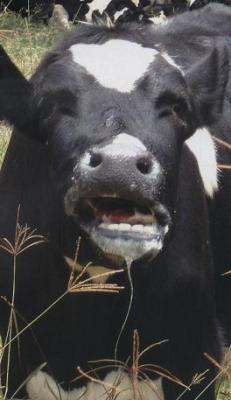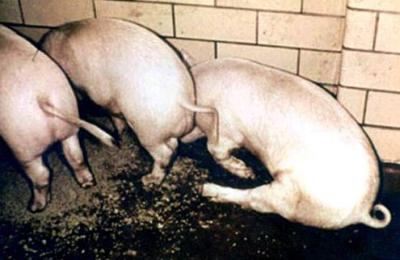Following diseases cause Paralysis, Stiffness and Lameness in animals are described below:
- Foot and Mouth Diseases (FMD) in of cattle, sheep, goats and pigs and buffalo
- Foot Rot in cattle, sheep and goats
Following are described under the indicated section:
- Rabies (see under Zoonotic diseases)
- Tetanus (see under Zoonotic diseases)
- Milk-Fever
Foot and Mouth Diseases (FMD)
|
Scientific name: Aphtae epizooticae Local names: Luo: olawo, achany / Maragoli: azuya / Gikuyu: muguruma / Gabbra: oyale / Kamba:muthingithu / Kipsigis:ngworek / Maasai: Olkuluk, loirobi, olguluk / Samburu: ikulup / Somali: dila, labeb, abeb, abeeb / Swahili: ugonjwa wa miguu na midomo / Turkana:lojaala, ebaibai, lokulup / Luidakho: man'gwali / Luvugusu: gamalenge / Nandi: maikutiet Common names: afthosa, aphthos fever, fievre aphteuse (French) fiebre aftosa (Spanish) Hosts: cattle, sheep, goats and pigs, can also affect wild animals, especially buffalo
Introduction
Foot and mouth disease is a highly contagious viral infectious disease of cattle, sheep, goats and pigs. It can also affect wild animals, especially buffalo, which act as significant hosts, and in which the disease is generally much milder than in cattle. It is caused by seven serotypes of Foot and Mouth disease virus namely: A, O, C, SAT 1, SAT 2, SAT 3 and ASIA 1. Mode of spread The virus can be harboured for periods in the nose and throat of wild animals. The importance of the disease in small stock such as sheep and goats is largely as carriers of the disease to cattle; but in Kenya it has been shown that goats are infrequent carriers and sheep not at all. The disease is enzootic in many parts of the world. FMD is mainly transmitted through inhalation or ingestion of the virus from contaminated feeds and direct contact with infected animals. The incubation period is on average 3 to 8 days after the animals are infected with the virus. Infected animals will then discharge the virus to materials they are in contact with or directly to other animals, thereby infecting them. This can be through the saliva, rupture of vesicles and blisters on the tongue and feet, discharges from the nose, and through coughs. Meat, milk and semen from infected animals can spread infection. Humans can also transfer infection to other animals through movement of people and vehicles from infected premises to susceptible areas. People working with infected cattle can harbour the virus in their nasal mucosa for up to 28 hours. Ticks also spread infection. Windborne spread can be important under certain conditions as can spread by flocks of birds. The important thing to remember is that this is one of the most contagious diseases known, and to act accordingly by taking every possible measure to prevent the entry of infection. Most animals recover but there is a frequent chronic and sometimes permanent loss of condition. In some instances, heart failure may occur causing sudden death. Mortality in calves is high. |
|
Signs of foot and mouth disease
- Severe lameness, due to the presence of blisters and vesicles between the toes, which then rupture and become secondarily infected
- The animals develop a high fever, become weak and dejected, and there is a rapid loss of condition. Mortality in calves is high
- Cattle stop eating due to the pain arising from the lesions in the mouth
- There is a drastic drop in milk production
- The coat becomes rough and there are blisters and vesicles inside the mouth especially on the tongue. There is profuse salivation with long ropey strings of saliva, and a characteristic smacking of the lips
- Blisters also form above and between the claws, and some blisters appear on the teats.
- Abortion is common
- Most animals recover but there is a frequent chronic and sometimes permanent loss of condition.
- In some instances, heart failure may occur causing sudden death
- Any combination of salivation and lameness with blisters and vesicles in the mouth must always be regarded as being Foot and Mouth Disease until proved otherwise
- Sheep and goat suffer a much milder disease than cattle
- Also pigs can be affected by Foot and Mouth disease:
|
|
|
Typical posture of pigs with painful blisters on the feet |
|
© USDA
|
Diagnosis
- Clinical signs and history
- Samples of vesicular fluids and epithelium can be sent to the lab for confirmation and sero typing at FMD Research Institute at Embakasi in Nairobi, Kenya.
- Differentiate diagnosis with Foot rot for leg and foot lesions. The disease can also be confused with Bluetongue.
Diseases with similar symptoms
- Leg and feet lesion: see Foot rot
- Mouth lesions: see Rinderpest
- In sheep can be confused with Bluetongue
Prevention - Control - Treatment
Prevention and Control
- Report occurrence immediately so as to invoke quarantine after the disease is confirmed by the veterinary authorities. Such quarantines should be lifted only by the authorities, usually 6 weeks after the last recorded case.
- Disinfect premises and motor vehicle tyres with suitable disinfectant to prevent further infections.
- Vaccinate regularly. This should be done after determining the strain of the virus in order to give the correct sero type vaccine. Usually a multivalent vaccine is administered every 6 months as preventive measure. Outbreaks have occurred following vaccination and have been attributed to the production of carrier animals.
- Strict adherence to sanitary measures e.g. destruction of feed and beddings of infected animals.
Recommended treatment
There is no medical treatment for Foot and Mouth Disease. However, you can help the animals to recover:
- Shade them from the sun and give them plenty of water
- Give them soft feed such as green, soft, lush grass, which is better than hay as the blisters make it painful for the animals to eat. The addition of molasses is advised to give the animals energy.
- Use Magadi soda for foot baths and wound treatment.
- Give antibiotics by intramuscular injection to prevent secondary infection of the blisters.
|
WARNING: Do not give antibiotics by mouth to adult cattle, camels, sheep and goats. It makes these animals sick by destroying essential bacteria in their rumens that are there as a vital part of the digestive process. |
Common traditional practices
Some of these are sensible and useful. Feeding of easily digested energy feeds are very beneficial as are disinfection of wounds with Magadi soda.
- Kipsigis: Mix 10kg of maize flour in 10 litres of water. Add 2kg of pounded finger millet. Allow to ferment for 3 days. Give an infected animal 4 litres of this brew to drink. Treatment for hooves: Spread 5kg of ash or 5kg of Magadi soda mixed with 5kg of ash in the morning and in the evening, at the entrance of the boma so the cattle must walk through it on the way to graze and when they return.
- Luo: Pound half a handful of fresh olulusia (Vernonia amygdalina) roots. Mix with 4kg of finger millet flour and 5 litres of water. Sieve and drench adult cattle with 2 litres (1 litre for calves, goats and sheep) twice a day until recovery.
- Turkana: Mix 500g of Magadi soda in 5 litres of water. Use the mixture to treat wounds in the mouth and externally on feet and teats. Repeat twice a day until recovery.
Revision process
1. Draft by Dr William Ayako, Aug - Dec 2009
2. Review by Dr Hugh Cran March 2010 - Jan 2011
3. Review workshop team. Nov 2 - 5, 2010
4. Addition of information by Dr Mario Younan, VSF-G, October 2013
- For Infonet: Anne Bruntse, Dr Hugh Cran
- For KARI: Dr Mario Younan KARI/KASAL, William Ayako - Animal scientist, KARI Naivasha
- For DVS: Dr Josphat Muema - Dvo Isiolo, Dr Charity Nguyo - Kabete Extension Division, Mr Patrick Muthui - Senior Livestock Health Assistant Isiolo, Ms Emmah Njeri Njoroge - Senior Livestock Health Assistant Machakos
- Pastoralists: Dr Ezra Saitoti Kotonto - Private practitioner, Abdi Gollo H.O.D. Segera Ranch
- Farmers: Benson Chege Kuria and Francis Maina Gilgil and John Mutisya Machakos
- Language and format: Carol Gachiengo
Information sources
- Barber, J., Wood, D.J. (1976) Livestock management for East Africa: Edwar Arnold (Publishers) Ltd 25 Hill Street London WIX 8LL
- Blood, D.C., Radostits, O.M. and Henderson, J.A. (1983) Veterinary Medicine - A textbook of the Diseases of Cattle, Sheep, Goats and Horses. Sixth Edition - Bailliere Tindall London. ISBN: 0702012866
- Blowey, R.W. (1986). A Veterinary book for dairy farmers: Farming press limited Wharfedale road, Ipswich, Suffolk IPI 4LG
- Force, B. (1999). Where there is no Vet. CTA, Wageningen, The Netherlands. ISBN 978-0333-58899-4.
- Hall, H.T.B. (1985). Diseases and parasites of Livestock in the tropics. Second Edition. Longman Group UK. ISBN 0582775140
- Hunter, A. (1996). Animal health: General principles. Volume 1 (Tropical Agriculturalist) - Macmillan Education Press. ISBN: 0333612027
- Hunter, A. (1996). Animal health: Specific Diseases. Volume 2 (Tropical Agriculturalist) - Macmillan Education Press. ISBN:0-333-57360-9
- ITDG and IIRR (1996). Ethnoveterinary medicine in Kenya: A field manual of traditional animal health care practices. Intermediate Technology Development Group and International Institute of Rural Reconstruction, Nairobi, Kenya. ISBN 9966-9606-2-7.
- Khan CM and Line S (2005): The Merck Veterinary Manual, 9th Edition, Merck & Co Inc Whitehouse Station NJ USA
- Martin WB (Editor)1983: Diseases of Sheep. Blackwell Scientific Publications ISBN 0-632 -01008 -8
- Mugera, Bwangamoi & Wandera 1979: Diseases of Cattle in Tropical Africa. Kenya Literature Bureau Nairobi
- Onderstepoort Henning 1956: Animal Diseases in South Africa 3rd Edition
- Pagot, J. (1992). Animal Production in the Tropics and Subtropics. MacMillan Education Limited London
- Sewell MMH and Brocklesby DW (editors)(1990): Handbook on Animal Diseases in the Tropics, 4th Edition 1990. Balliere and Tindall, 24-28 Oval Road, London NW1 7DX, UK. ISBN NO: 0-7020-1502-4
- Sewell and Brocklesby, Editors 1990: Handbook on Animal Diseases in the Tropics 4th Edition. Bailliere Tindall ISBN 0-7020-1502-4
- The African Veterinary Handbook Mackenzie & Simpson 1964 Pitman, Nairobi
- The Merck Veterinary Manual 9th Edition Kahn & Line 2005 ISBN 0-911910-50-6
- Veterinary Medicine A Textbook of the Diseases of Cattle, Sheep, Pigs, Goats and Horses 1983 6th Edition Blood, Radostits and Henderson ELSB & Bailliere Tindall ISBN 0-7020-0988-1


